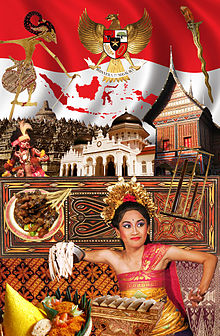
Back الثقافة الإندونيسية Arabic İndoneziya mədəniyyəti Azerbaijani Kebudayaan Indonésia BEW Cultura de Indonesia Spanish فرهنگ در اندونزی Persian Culture indonésienne French Budaya Indonesia GOR इण्डोनेशिया की संस्कृति Hindi Budaya Indonesia ID インドネシア文化 Japanese

| Part of a series on the |
| Culture of Indonesia |
|---|
 |
| People |
| Languages |
| Mythology and folklore |
| Cuisine |
| Literature |
| Music and performing arts |
| Sport |
The culture of Indonesia (Indonesian: Budaya Indonesia) has been shaped by long interaction between original indigenous customs and multiple foreign influences. Indonesia is centrally-located along ancient trading routes between the Far East, South Asia and the Middle East, resulting in many cultural practices being strongly influenced by a multitude of religions, including Buddhism, Christianity, Confucianism, Hinduism, and Islam, all strong in the major trading cities. The result is a complex cultural mixture, often different from the original indigenous cultures.
Examples of the fusion of Islam with Hinduism include Javanese Abangan belief. Balinese dances have stories about ancient Buddhist and Hindu kingdoms, while Islamic art forms and architecture are present in Sumatra, especially in the Minangkabau and Aceh regions. Traditional art, music and sport are combined in a martial art form called Pencak Silat.
The Western world has influenced Indonesia in science, technology and modern entertainment such as television shows, film and music, as well as political system and issues. India has notably influenced Indonesian songs and movies. A popular type of song is the Indian-rhythmical dangdut, which is often mixed with Arabic and Malay folk music.
Despite the influences of foreign culture, some remote Indonesian regions still preserve uniquely indigenous culture. Indigenous ethnic groups Batak, Nias, Mentawai, Asmat, Dani, Sumba, Dayak, Toraja and many others are still practising their ethnic rituals, customs and wearing traditional clothes.[1]
- ^ Taylor, Jean Gelman (2003). Indonesia peoples and Histories. Yale University Press. ISBN 0-300-10518-5.
© MMXXIII Rich X Search. We shall prevail. All rights reserved. Rich X Search